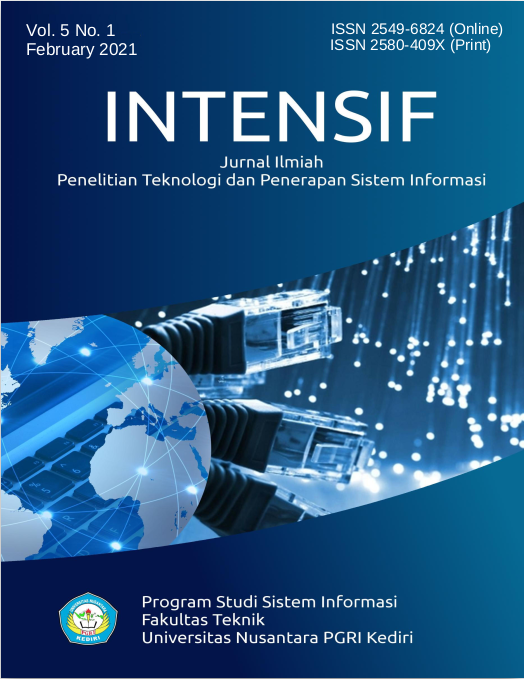Code of Conduct Information System Using Simple Multi-Attribute Rating Technique (SMART) Method at SMK XYZ
DOI:
https://doi.org/10.29407/intensif.v5i1.14728Keywords:
SMK XYZ, Information System, Code of Conduct, SMARTAbstract
SMK XYZ is a vocational high school with approximately 2550 students with various majors and backgrounds, so there are many problems. For subscribers, each student gets a notebook on discipline and order; if a student commits a violation, it will be written by the discipline taught in the book. Furthermore, the counseling guidance teacher, together with the class teacher, conducts coaching; this activity is a manual system that has not been computerized. It hinders the performance of these teachers. From these problems, an order information system's analysis and design are carried out, which can facilitate and accelerate teachers in planning, directing, and monitoring. The SMART method's application to the discipline information system is based on the science of facts, which states a criterion with value; each weighted value can show and reflect comparisons between standards related to planning, direction, and supervision of students carried out by teachers. Subscription to violations using the discipline information system with the SMART method is carried out computerized, including determining sanctions and their actions to support the performance of teachers.
Downloads
References
S. Suradi, “Pembentukan Karakter Siswa melalui Penerapan Disiplin Tata Tertib Sekolah,” Briliant J. Ris. dan Konseptual, vol. 2, no. 4, p. 522, 2017.
A. Habib, M. A. Jani, D. A. Pratama, and E. Ronaldo, "Development of archives management information system with RFID and SMS gateway," Int. J. Psychosoc. Rehabil., vol. 24, no. 4, pp. 5227–5243, Feb. 2020.
P. P. J. T. Dinas Pendidikan, Tata Tertib Peserta Didik SMK Provinsi Jawa Timur. Pemerintah Provinsi Jawa Timur Dinas Pendidikan, 2018.
E. Y. Berutu, R. Elly, and M. N. Yusuf, “Implementasi tata tertib sekolah dalam membentuk kedisiplinan siswa Sekolah Dasar Negeri Gue Gajah Aceh Besar,” J. Ilm. Pendidik. Guru Sekol. Dasar FKIP Unsyiah, vol. 3, no. 2, pp. 76–81, 2018.
A. Irwansa and M. A. Maf’ul, “Analisis pelaksanaan tata tertib sekolah pada siswa di smk negeri 1 makassar,” Open J. Syst., vol. 2, pp. 1–13, 2018.
Z. F. J. Annisa, “Pelanggaran Tata Tertib Pada Kalangan Pelajar Sma Negeri 7 Banjarmasin,” Karya Tulis, pp. 1–25, 2014.
N. A. H. Lia Ciky Lumban Gaol, “Sistem Pendukung Keputusan Pemilihan Team Leader Shift Terbaik Dengan Menggunakan Metode Aras Studi Kasus Pt. Anugrah Busana Indah Lia,” Inf. dan Teknol. Ilm., vol. 13, no. 1, pp. 16–21, 2018.
R. M. Wibowo, A. E. Permanasari, and I. Hidayah, “Decision Support Systems With Profile Matching Method in Selection of Achievement Marketing Officer At Bri Katamso Yogyakarta,” Int. Conf. Sci. Technol. Humanit., pp. 115–124, 2015.
S. W. Ananta, Priranda Widara, “Sistem Pendukung Keputusan Dalam Penilaian Kinerja Pegawai Untuk Kenaikan Jabatan Pegawai Menggunakan Metode Gap Kompetensi (Studi Kasus Perusahaan Perkasa Jaya Compuretail),” J. Sarj. Tek. Inform., vol. 1, pp. 574–583, 2013.
J. Na’am, “Sebuah Tinjauan Penggunaan Metode Analythic Hierarchy Process (AHP) dalam Sistem Penunjang Keputusan (SPK) pada Jurnal Berbahasa Indonesia,” J. Mediasisfo, vol. 11, no. 1978–8126, pp. 888–895, 2017.
R. M. Wibowo, P. A. Erna, and I. Hidayah, “Heuristic evaluation and user testing with ISO 9126 in evaluating of decision support system for recommendation of outstanding marketing officer,” Proc. - 2017 Int. Conf. Sustain. Inf. Eng. Technol. SIET 2017, vol. 2018-Janua, pp. 454–458, 2018.
D. Novianti, I. Fitri Astuti, and D. M. Khairina, “Sistem Pendukung Keputusan Berbasis Web Untuk Pemilihan Café Menggunakan Metode Smart (Simple Multi-Attribute Rating Technique) (Studi Kasus : Kota Samarinda),” Pros. Semin. Sains dan Teknol. FMIPA Unmul, vol. 1, no. 3, pp. 461–465, 2016.
M. Safii and D. A. Saputri, “Penerapan Metode Simple Multi Attribute Rating Technique ( Smart ) Sebagai Motivasi Pegawai Dalam Peningkatan,” Mantik Penusa, vol. 2, no. 2. pp. 169–174, 2018.
Diana, “Sistem Pendukung Keputusan Menentukan Kelayakan Bisnis Menerapkan Simple Multi Attribute Rating Technique (SMART),” Ilm. Matrik, vol. 18, pp. 113–124, 2016.
A. Mulyanto and L. Ristina, “Penentuan Sanksi Pelanggaran Tata Tertib Sekolah Menggunakan Metode Simple Multi Attribute Rating Technique (SMART) Berbasis Php Dan Mysql Studi Kasus SMPN 10 Tambun Selatan,” J. Inform. SIMANTIK, vol. 3, no. 1, pp. 1–6, 2018.
D. Irwan, ukkas. Pratiwi, Heny. Purnamasari, “Sistem Pendukung Keputusan Penentuan Supplier Bahan Bangunan Menggunakan Metode Smart ( Simple Multi Attribute Rating Technique ) Pada Toko Bintang,” pp. 34–42, 2014.
A. Habib and A. Kartika W. H., “Development of an Online Sales Information System for SMEs Using Incremental Methods,” INTENSIF J. Ilm. Penelit. dan Penerapan Teknol. Sist. Inf., vol. 4, no. 1, pp. 51–62, 2020.
A. Habib and B. Al Kindhi, “Rancang Bangun Sistem Informasi Manajemen Keuangan Sekolah,” INTENSIF J. Ilm. Penelit. dan Penerapan Teknol. Sist. Inf., vol. 2, no. 2, p. 136, Aug. 2018.
S. Sucipto, N. C. Resti, T. Andriyanto, J. Karaman, and R. S. Qamaria, “Transactional database design information system web-based tracer study integrated telegram bot,” J. Phys. Conf. Ser., vol. 1381, no. 1, 2019.
Downloads
Published
Issue
Section
License
Authors who publish with this journal agree to the following terms:
- Copyright on any article is retained by the author(s).
- The author grants the journal, the right of first publication with the work simultaneously licensed under a Creative Commons Attribution License that allows others to share the work with an acknowledgment of the work’s authorship and initial publication in this journal.
- Authors are able to enter into separate, additional contractual arrangements for the non-exclusive distribution of the journal’s published version of the work (e.g., post it to an institutional repository or publish it in a book), with an acknowledgment of its initial publication in this journal.
- Authors are permitted and encouraged to post their work online (e.g., in institutional repositories or on their website) prior to and during the submission process, as it can lead to productive exchanges, as well as earlier and greater citation of published work.
- The article and any associated published material is distributed under the Creative Commons Attribution-ShareAlike 4.0 International License












